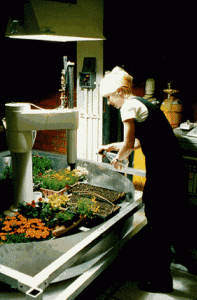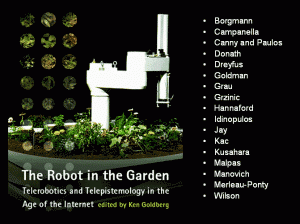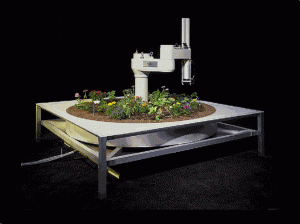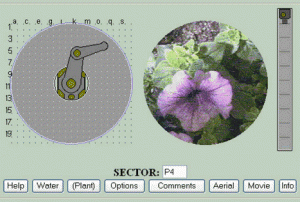Gianna Maria Gatti:
(translated from the Italian by Alan N. Shapiro)
All images © Copyright Ken Goldberg
Telegarden is a telerobotic installation that enables users of the World Wide Web to see and cultivate a real garden. Conceived in 1994, it was activated in June 1995 at the University of Southern California and presented, over the course of the summer, at the leading international exhibitions of digital art and technology, among which ‘SIGGRAPH ’95’ in Los Angeles. Since September 1996, Telegarden has been physically in Linz, Austria, at the Digital Media Museum of the Ars Electronica Center.
The garden has a circular form and grows on the inside of a metallic container about fifty centimeters deep, with a diameter of about two meters; at the center the robot dominates, the only manager and supervisor of this blooming flowerbed. The robot is always ready, with its swiveling arm, to carry out the orders given by the ‘gardeners’ scattered all over the world. To take care of the garden, in fact, it is not necessary to travel personally to the place where it is situated; the only requirement is a computer equipped with an Internet connection. Surfing to the website of Telegarden, it is the garden itself which enters into the homes of the users, providing them with information and instructions regarding its condition and care, as well as guiding the users, if they so request, in the general practice of gardening. The image that appears on the screen is a simulated view of the garden from above in real time – a comprehensive graphic of the robotic arm captured in its mobile position; next to this scheme one sees the real shot of the portion of the garden made visible by the video camera placed at the extremity of the robotic arm. Clicking on any point of the graphic, the robot moves to the position indicated by the user and takes a snapshot which after a few seconds is made visible on the screen by the system. This exploration at a distance of the garden and the possibility of posting a comment are interactions open to all users, including occasional ‘guests’. For those, however, who decide to become members of Telegarden, the opportunities for action and participation increase. Registering a personal e-mail address grants one access rights to the community of Telegarden and the possibility of enjoying the privileges which it offers: practical privileges relating to the care of the garden such as seminars, watering rights, monitoring the growth of the plants and advantages of a technical nature, linked to the production of the visual image of the garden. The members can in addition communicate with each other, exchanging information and comments about the garden or other topics, thanks to a special chat system called ‘Village Square’ that fosters this dialogue.
For Goldberg, Telegarden is a “living model of small-planet social interactions”: a small planet whose organization is founded on the combination of several factors, technological (informatics, robotics, Internet, telepresence) and organic (vegetation). To activate their interrelationship, an almost unlimited number of persons, navigators of the network from every part of the world, come together in Telegarden and interact with the shared goal of making the garden live and grow.
This is the kind of evolution that was missing in Mercury Project, the first interactive installation that was the fruit of Goldberg’s robotic research, to which the artist applied the potential of the Internet to enable the telerobotic manipulation of a remote environment. In the course of two-and-a-half million hits on the site over seven months in which it was continuously online, the navigators were invited to dig up from the sand objects contained in a sand-filled box simulating an archeological excavation. In spite of the innovative conception of making a robotic artwork available twenty-four hours a day, to multiple users in real time, the project turned out to be unsatisfactory for its own creators, in that the purpose was to discover simple pre-established objects: a search that, as an end in itself, showed all of its limits in the repetitiveness of the actions and the predictibility of the outcome. Therefore the concept was extended in the following work, introducing an uncontrollable, non-programmed element, which consisted in adding an organic component to the high technology of the web: the development of growth of a plant, in fact, has a speed which, unlike the electronic one, can be neither compressed nor accelerated. One of the principal objectives of Telegarden is to emphasize the properties of the two opposed realities, the living organism and the technological component, in order that, after having been compared with and related to each other, they combine in a reciprocal exchange, one supporting the other. Moreover, the entire process leads the user to experiment with a different approach to both, empowering him to discover a new mode of interpreting both the old consolidated practice of gardening as well as the more recent but by now familiar navigation of the net. The garden, characterized by being situated in a stable way in a place, and by having a slow biological dynamic of growth, is entrusted by Goldberg to the Internet, the omnipresent media of communication the speed of which guarantees the continuous and constantly updated flow of information. And that is exactly what plants need to live: several people who take care of them with regularity and tenacity, the process made easier by being able to do it comfortably from one’s own computer. On the other hand, offering Internet users a natural goal made up of cells and delicate vital equilibria, of which they take care step by step, permits them to make a different use of this media.
 Goldberg points out the two modes of behavior that are typical of navigation in the network: ‘hunting’ and ‘gathering’. Pierre Lévy provides a useful explanation here: the former consists in the search for circumscribed information that one wishes to reach as quickly as possible. This is equivalent to purposive action that has the goal of obtaining a specific result. The latter, by contrast, is a search that starts out without any well-defined goal, and precisely for this reason, ends up losing itself in the variegated supply of alternatives which circulate on the web. The aimless wandering from site to site is transformed into a composite gathering of often unforeseen data. To these two emblematic attitudes of the navigator, which can also involuntarily coexist, is counterposed the ethics of Telegarden, which makes the user return to the same site over and over again, seduced by the lure of participating in the unusual cultivation at a distance of a garden, and being able to verify the consequences of one’s actions. Dialogue with the web is not exhausted by the mere discovery and exchange of data. In this case, it becomes a sharing of material resources aimed at the maintenance of the site itself, essential to its physical survival.
Goldberg points out the two modes of behavior that are typical of navigation in the network: ‘hunting’ and ‘gathering’. Pierre Lévy provides a useful explanation here: the former consists in the search for circumscribed information that one wishes to reach as quickly as possible. This is equivalent to purposive action that has the goal of obtaining a specific result. The latter, by contrast, is a search that starts out without any well-defined goal, and precisely for this reason, ends up losing itself in the variegated supply of alternatives which circulate on the web. The aimless wandering from site to site is transformed into a composite gathering of often unforeseen data. To these two emblematic attitudes of the navigator, which can also involuntarily coexist, is counterposed the ethics of Telegarden, which makes the user return to the same site over and over again, seduced by the lure of participating in the unusual cultivation at a distance of a garden, and being able to verify the consequences of one’s actions. Dialogue with the web is not exhausted by the mere discovery and exchange of data. In this case, it becomes a sharing of material resources aimed at the maintenance of the site itself, essential to its physical survival.
On the indispensable interaction between user and garden is founded the second of the objectives pursued by the Telegarden team: that of making users realize that they are not alone in taking care of the living installation. In Telegarden, as the authors make clear, the people become aware of the electronic presence of the others while engaging in the shared goal of taking care of the plants, interrupting their ‘skipping’ around from one site to the next, stopping to ‘smell the roses’. If navigation is usually impersonal and renders invisible the reality that there are other users connected to the same site, Telegarden attempts to reduce this feeling of ‘solitude’. Telegarden does not limit itself to awakening awareness in its users of how the web can be used at the same time by several persons. The installation makes sense only in so far as it is a community of navigators who collaborate together, grouped around an environment. The configuration of Telegarden leads its members to understand the importance of interacting and encountering each other. The state of self-management in which they are left tries intentionally to make them responsible for their choices, bringing them face-to-face with the problems of a virtual community: for example, acts of sabotage. “Despite the horticultural setbacks, the Telegarden succeeded in its goal of propagating a ‘post-nomadic’ community, where survival favors those who collaborate.”
The authors go back through the history of humanity, gathering as a reference point for their community the Neolithic Revolution, which around eight thousand years B.C. saw prehistoric man abandon the condition of nomadic hunter-gatherer in favor of allocated settlements devoted to cultivation and animal breeding. Hence the parallel with Telegarden, which carves out its own territory from inside the Internet, returning to the ‘agricultural dimension’ the users who wander about the web like nomads in continuous ‘hunting and gathering’. Goldberg’s installation can in this sense be related to the notion of Territory elaborated by Pierre Lévy, which is part of his theory of the four anthropological spaces: “Territorial space arose during the Neolithic Period with the development of agriculture, the city, the state, and writing. This second space did not eliminate the great nomadic Earth but partially covered it and attempted to turn it into something sedentary, domesticated. Hunting and gathering were no longer a source of wealth, but the possession and exploitation of fields… The pivot of existence was no longer participation in the cosmos but the link to a territorial entity (affiliation, property, etc.) defined by its borders.”
And that is what develops the small flowerbed of Telegarden, in which a certain number of strangers initially find a space to make their own, within the infinite routes of the web, displaying a need to stop and commit to something stable. The garden becomes a reference point for which one’s affection grows, in which there are other members who express these same sentiments and with whom one can form new friendships. The desire to construct something together and to confront oneself as a group reinforces the bond of community that has been created: this sharing generates a whole series of dynamics of socialization, exchanges, and moments of complicity. This new post-nomadic community dedicated to agriculture adjusts to its own times, reflects its own cultural technological epoch, and acts making use of the tools that set it apart: information technology and robotics. Contact with the Earth passes through a mouse, a computer screen, the Internet. Although the sensorial pleasure arising from direct manipulation, olfactory perception and, in some cases, the tasting of products is lost, Goldberg’s purpose is not to make Telegarden a substitute for true gardening but, on the contrary, to present it as a valid alternative and partner to ‘the real’, an incentive for the rediscovery of this practice.
Cultivation also occurs via a robotic arm physically in contact with the garden that distributes the material substances necessary to the life of the plants. The original symbiosis established among robot, Internet and nature is interpreted ironically by Goldberg: “A garden is meant to be a refuge from technology. Robots are meant to go into places that are dangerous – places we don’t want to be. So sending a robot into a garden is probably the most absurd application of telerobotics!”… The Telegarden is a metaphor for the deepening intrusiveness of technology, in particular the Internet.”An Adept robot simulating human arm structure, usually engaged in productive industrial activity, therefore very fast, has been personalized and equipped with special devices by the computer scientist Jeff Wiegley to make it skillful at digging, sowing, and watering as well as satisfying in the shortest time possible the requests of all the gardeners who maneuver it from their computers via the Internet. The so-called ‘collective intelligence’ flows together into a single executor, a single arm corresponding to hundreds of minds. Steven Gentner comments: “When viewing the robot physically it certainly does appear that it is alive and knows what it is doing. However it is simply responding to a collective intelligence that exists in many different locations. Two heads are better than one… imagine if you have thousands!”
The great support for the community of Telegarden – after only one year it numbered nine thousands members – persuaded the staff to regulate the sowing to avoid the overcrowding of the plants. Cultivation privileges were granted based on the number of contacts made, attesting to the real attachment to the garden, and on the registration as a member for a given period. The gardeners of Telegarden cultivate with the mouse but the result is an authentic garden, completely natural and in continuous evolution: flowers and edible vegetables such as tomatoes and radishes grow there, insects circulate there. The garden has its own demands which must be respected. The environment must maintain a constant temperature and a regular illumination composed of solar light as well as light artificially produced by lamps for a duration of fifteen hours a day. Periodic maintenance is also necessary: weeding, pruning, and transplanting when the growth becomes too dense. Every six months a complete replacing of the soil is indispensable, an operation that, on the one hand, facilitates the control of the mechanical components of the installation, which inevitably wear out, on the other hand, it permits the upgrading of the informatic apparatus. Direct action on the spot by a staff of assistants is unavoidable because the set of actions triggerable via the Internet that the robot can carry out are limited. Knowledge of this has fueled the attitude of a group of skeptics, incredulous that the commands imparted at a distance are actually those which provide for the garden. There is a second group of skeptics who have raised the doubt that the garden does not really exist, that it is only a transmitted image.
Goldberg has responded to these doubts by making them an object of reflection. He has converted the accusations, which could have given rise to sterile polemics, into an analysis of knowledge at a distance examined in its various implications. According to the artist, philosophical interrogations must run parallel to technological evolution: “As the telescope and microscope raised epistemological questions that inspired Descartes’ method of doubt, web cameras and telerobotic systems on the Internet suggest new epistemological terrain.” Goldberg has dubbed “this sub-genre of meta-knowledge ‘telepistemology’, how we know what we know when our perception is technologically mediated.” On this concept, Goldberg has published the study The Robot in the Garden: Telerobotics and Telepistemology in the Age of the Internet, which assembles a series of contributions by philosophers, art historians, and scientists. Several successive installations by Goldberg have marked by Telepistemology, elaborations of what he has theorized.
 Goldberg’s inquiry is situated in an epoch which is constantly confronting itself with everything that is ‘tele-‘ or ‘remote’. As he asserts with irony: “We are entering a ‘tele’-centric age. We have teleconferencing, telecommuting, and telepresence. Even preschoolers have Teletubbies… One of the Teletubbies executives says that ‘the beauty of Teletubbies is that they offer children a mirror on their world’.”An age that places at its center everything that is at a distance, and whose purpose is none other than the shortening of distances – geographical, temporal, cultural – with all the media that increasingly evolved technology offers to it.
Goldberg’s inquiry is situated in an epoch which is constantly confronting itself with everything that is ‘tele-‘ or ‘remote’. As he asserts with irony: “We are entering a ‘tele’-centric age. We have teleconferencing, telecommuting, and telepresence. Even preschoolers have Teletubbies… One of the Teletubbies executives says that ‘the beauty of Teletubbies is that they offer children a mirror on their world’.”An age that places at its center everything that is at a distance, and whose purpose is none other than the shortening of distances – geographical, temporal, cultural – with all the media that increasingly evolved technology offers to it.

